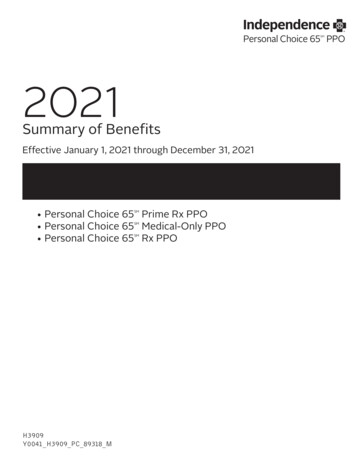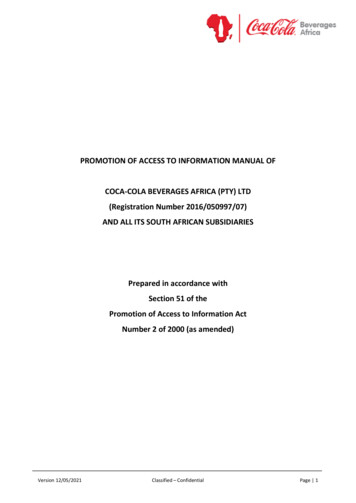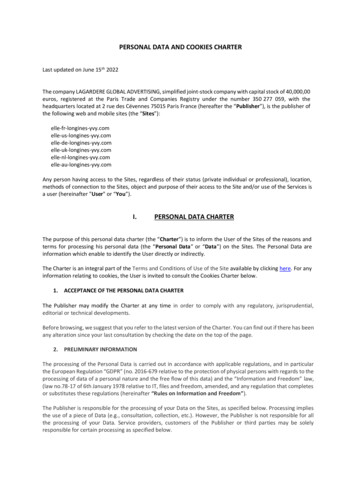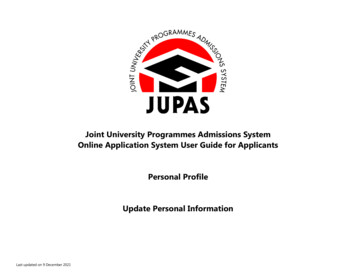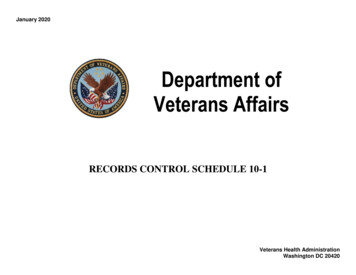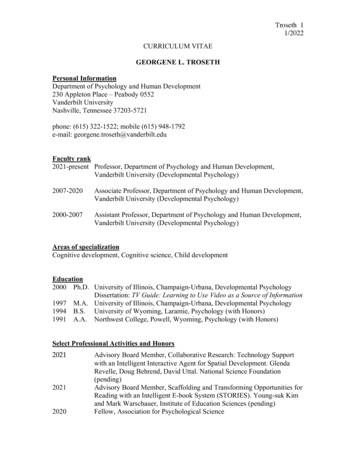
Transcription
Troseth 11/2022CURRICULUM VITAEGEORGENE L. TROSETHPersonal InformationDepartment of Psychology and Human Development230 Appleton Place – Peabody 0552Vanderbilt UniversityNashville, Tennessee 37203-5721phone: (615) 322-1522; mobile (615) 948-1792e-mail: georgene.troseth@vanderbilt.eduFaculty rank2021-present Professor, Department of Psychology and Human Development,Vanderbilt University (Developmental Psychology)2007-2020Associate Professor, Department of Psychology and Human Development,Vanderbilt University (Developmental Psychology)2000-2007Assistant Professor, Department of Psychology and Human Development,Vanderbilt University (Developmental Psychology)Areas of specializationCognitive development, Cognitive science, Child developmentEducation2000 Ph.D. University of Illinois, Champaign-Urbana, Developmental PsychologyDissertation: TV Guide: Learning to Use Video as a Source of Information1997 M.A. University of Illinois, Champaign-Urbana, Developmental Psychology1994 B.S. University of Wyoming, Laramie, Psychology (with Honors)1991 A.A. Northwest College, Powell, Wyoming, Psychology (with Honors)Select Professional Activities and Honors202120212020Advisory Board Member, Collaborative Research: Technology Supportwith an Intelligent Interactive Agent for Spatial Development. GlendaRevelle, Doug Behrend, David Uttal. National Science Foundation(pending)Advisory Board Member, Scaffolding and Transforming Opportunities forReading with an Intelligent E-book System (STORIES). Young-suk Kimand Mark Warschauer, Institute of Education Sciences (pending)Fellow, Association for Psychological Science
Troseth 21/20222019Vanderbilt WeBooks (TIPS adaptive eBooks) listed in the PromiseVenture Studio Glossary of Innovations for Early pant, Media Exposure and Early Child Development Workshop,National Institutes of Health (NICHD)2017-2018Advisory Board, Evaluation of Sesame Street Kindness Curriculum,Mary Louise Hemmeter & Erin Barton (co-PIs). Sesame Workshop2016Provided input for the American Academy of Pediatrics updated digitalmedia recommendation for young children2015David Schleyer Faculty Award, Peabody College, for outstandingmentoring of undergraduate students2015Interviewed for SRI International report (PBS Kids Ready to Learngrant): Reflections on the Ready to Learn Initiative, 2010-2015: How aFederal Program in Partnership with Pubic Media Supported YoungChildren’s Equitable Learning During a Time of Great Change.http://cct.edc.org/rtl/2013Vanderbilt Kennedy Center acknowledgment for welcoming Next StepsProgram at Vanderbilt students into my classes2008-2010Advisory Board Member, IRADS Collaborative Research: Influences ofDigital Media on Very Young Children. National Science Foundation.2007Sesame Workshop; Infant and Toddler Roundtable expert discussionof Sesame Beginnings DVDs with reference to toddlers’ learning abilities2004-2007Peabody Faculty Incentive Award Recipient, External Grant Funding,Vanderbilt University2001-present Investigator, John F. Kennedy Center for Research on HumanDevelopment, Vanderbilt University2001Affirmative Action & Diversity Certificate of Recognition, Vanderbilt2001Distinguished Alumni Award, Academic Achievement, Northwest CollegeMember:Association for Psychological ScienceCognitive Development SocietyInternational Society on Infant StudiesSociety for Research in Child DevelopmentPublicationsBook chapters (*student authors)Troseth, G.L., *Flores, I., & *Stuckelman, Z. D. (2019). When representation becomesreality: Interactive digital media and symbolic development. In J. Benson (Ed.),Advances in Child Development and Behavior, Vol. 56 (pp. 65-108). London,UK: Elsevier.Revelle., G. L., Strouse, G. A., Troseth, G. L., Rvachew, S., & *Thompson Forrester, D.(2019). Technology support for adults and children reading together: Questionsanswered and questions raised. In J. E. Kim & B. Hassinger-Das (Eds.), Reading
Troseth 31/2022in the digital age: Young children’s experiences with e-books. Internationalstudies with e-books in diverse contexts (pp. 103-132). NY: Springer.Troseth, G.L., Mancilla-Martinez, J., & *Flores, I. (2018). Bilingual children: Activelanguage learners as language brokers. In M. M. Saylor and P. A. Ganea (Eds.),Active learning from infancy to childhood: Social motivation, cognition, andlinguistic mechanisms (pp. 233-259). NY: Springer.Troseth, G. L., Strouse, G. A., & *Russo, C. E. (2017). Early digital literacy:Learning to learn from video. In F. Blumberg & P. Brooks (Eds.), Cognitivedevelopment in digital contexts (pp. 29-52). London, UK: Elsevier.Troseth, G.L., *Russo, C.E., & Strouse, G.A. (2017). What’s next for research onyoung children’s interactive media? In D. Lemish, A. Jordan, & V. Rideout(Eds.), Children, adolescents, and the media: The future of research in action (pp.54-62). London: Routledge.Troseth, G. L. (2007). Learning from video: Young children’s understanding and useof a symbolic medium. In E. Teubal, J. Dockrell, & L. Tolchinsky (Eds.)Notational knowledge: Developmental and historical perspectives (pp. 179-202).Rotterdam, The Netherlands: Sense Academic Publishers.Troseth, G. L., Pierroutsakos, S. L., & DeLoache, J. S. (2004). From the innocent tothe intelligent eye: The early development of pictorial competence (pp. 1-35). InR. Kail (Ed.), Advances in Child Development and Behavior, Vol. 32. New York:Academic Press.Uttal, D. H., Marzolf, D. P., Pierroutsakos, S. L., Smith, C. M., Troseth, G. L., &DeLoache, J. S. (1998). "Seeing through symbols? The development of children'sunderstanding of symbolic relations." In B. Spodek & O. Saracho (Eds.), Play inEarly Childhood Education (pp. 59-79). Albany: SUNY Press.DeLoache, J. S., Pierroutsakos, S. L. & Troseth, G. L. (1996). The three R’s of pictorialcompetence. In R. Vasta (Ed.), Annals of Child Development, Vol. 12 (pp. 1-48).London: Jessica Kingsley.Invited encyclopedia entry for researchers, service professionals, policy-makers, andparentsCourage, M. & Troseth, G. L. (2016). Infants, toddlers and learning from screen media.In R.E. Tremblay, M. Boivin, & R.D. Peters (Eds), Encyclopedia on EarlyChildhood Development. (http://www.child-encyclopedia.com/)Invited article in a journal for professionals, policy-makers, & parentsBarr, R., Blanchfield, O., McClure, E., Roche, E., Zosh, J. M., Strouse, G., Troseth, G., &Myers, L. (2020). Virtual family time: How families connect via video chat.
Troseth 41/2022Zero to Three, 41(2), 21-29. seth, G.L., *O’Doherty, K., & *Strouse, G.A. (2013). Trusting the tube: Currentinformation about an established technology. Zero to Three, 33(4), 25-31.Report to Nonprofit Organization (Funders)Kakulla, B., Barr, R., McClure, E., Myers, L. J., Strouse, G. A., Troseth, G. L., & Zosh, J.M. (November 2020). Boomers and Zoomers: How grandparents are using videochat to connect with their grandchildren during the pandemic. Washington, DC:AARP (American Association of Retired People) les in Refereed Journals*Stuckelman, Z. D., Troseth, G. L., & Strouse, G. A. (2021). Value added:Digital modeling of dialogic questioning promotes positive parenting duringshared reading. Journal of Family Psychology. DOI: 10.1037/fam0000932*Russo Johnson, C. R., *Flores, I., & Troseth, G. L. (2021). Do young children ofthe “Selfie generation” understand digital photos as representations? HumanBehavior and Emerging Technologies, 3(4), 512-524.https://doi.org/10.1002/hbe2.287Strouse, G.S., McClure, E., Myers, L. J., Zosh, J. M., Troseth, G. L. Blanchfield, O.,Roche, E., *Malik, S., & Barr, R. (2021). Zooming through development: Usingvideo chat to support family connections during COVID-19. Human Behaviorand Emerging Technologies, 3(4), 552-571. DOI: 10.1002/hbe2.268Troseth, G.L., Strouse, G.S., *Flores, I., *Stuckelman, Z., & *Russo Johnson, C.R.(2020). An enhanced eBook facilitates parent-child talk during shared reading byfamilies of low socioeconomic status. Early Childhood Research Quarterly, 50,45-58. Special issue on the Word Gap.DOI: sen, E. E., Strouse, G. A., Colwell, M. J., *Russo, C., *Holiday, S., *Brady, K.,*Flores, I., Troseth, G., *Wright, H., *Densley, R., & *Norman, M. (2019).Promoting preschoolers’ emotional competence through prosocial TVand mobile app use. Media Psychology, 22(1), Troseth, G.L., Strouse, G.A., Verdine, B.N., & Saylor, M.M., (2018). Let’s chat: Onscreen social responsiveness is not sufficient to support toddlers’ word learningfrom video. Frontiers in Psychology: Developmental Psychology, 9, Article ID2195. http://dx.doi.org/10.3389/fpsyg.2018.02195
Troseth 51/2022Strouse, G.A., Troseth, G.L., O’Doherty, K.D., & Saylor, M.M. (2018). Co-viewingsupports toddlers’ word learning from contingent and non-contingent video.Journal of Experimental Child Psychology, 166, 310-326. doi:10.1016/j.jecp.2017.09.005.*Russo Johnson, C., Troseth, G., *Duncan, C. A., *Mesghina, A. (2017). All tapped out:Touchscreen interactivity and young children’s word learning. Frontiers inPsychology. 8(578). doi: 10.3389/fpsyg.2017.00578.Troseth, G.L., & Strouse, G.A. (2017). Designing and using digital books for learning:The informative case of young children and video. International Journal of ChildComputer Interaction Special Issue: E-reading with .002Kirkorian, H.L., Lavigne, H.J., *Hanson, K.G., Troseth, G.L., *Demers, L.B., &Anderson, D.R. (2016). Video deficit in toddlers’ object retrieval: What eyemovements reveal about online cognition. Infancy, 21, 37-64. DOI:10.1111/infa.12102Troseth, G.L., *Russo, C.E., & Strouse, G.A. (2016). What’s next for research onyoung children’s interactive media? Journal of Children and Media, 10(1), 54-62.Anniversary Issue. DOI: 10.1080/17482798.2015.1123166*Strouse, G.A. & Troseth, G.L. (2014). Supporting toddlers’ transfer of word learningfrom video. Cognitive Development, 30, 47-64.*Strouse, G.A., *O’Doherty, K.D., & Troseth, G.L. (2013). Effective co-viewing:Preschoolers’ learning from video after a dialogic questioning intervention.Developmental Psychology, 49(12), 2368-2382.*O’Doherty, K., Troseth, G.L., Shimpi, P., *Goldenberg, E., Akhtar, N. & Saylor, M.M.(2011). Third-party social interaction and word learning from video. ChildDevelopment, 82, 902-915.DeLoache, J.S., *Chiong, C., *Vanderborght, M., *Sherman, K., *Islam, N., Troseth,G.L., *Strouse, G.A., & *O’Doherty, K. (2010). Do babies learn from babymedia? Psychological Science. 21. 1570-1574.(As senior author, DeLoache listed her students before my lab group; original ideas andresearch contributions were equal.)Troseth, G.L (2010). Is it life or is it Memorex? Video as a representation of reality.Developmental Review, 30, 155-175.Troseth, G.L., *Strouse, G.A., *Verdine, B.V., & *O’Doherty, K. (2010). Do very young
Troseth 61/2022children learn from video? Revista Irice, Número Monográfico: RepresentacionesExternas (Special Issue: External Representations), 21, 13-25.Saylor, M., Sabbagh, M., *Fortuna, A., & Troseth, G. (2009). Preschoolers use aspeaker’s preferences to learn words. Cognitive Development, 24, 125-132.Diener, M., Pierroutsakos, S. P., Troseth, G. L., & Roberts, A. (2008). Video versusreality: Infants' attention and affective responses to video and live presentations.Media Psychology, 11, 418-441.*Strouse, G. A. & Troseth, G. L. (2008). Don’t try this at home: Toddlers’ imitation ofnew skills from people on video. Journal of Experimental Child Psychology, 101,262-280.*Verdine, B. N., Troseth, G. L., Hodapp, R. H., & Dykens, E. M. (2008). Strategies andcorrelates of jigsaw puzzle and visuospatial performance by person with PraderWilli syndrome. American Journal on Mental Retardation, 113(5), 343-355.Troseth, G. L., *Bloom Picard, M. E. & DeLoache, J. S. (2007). Young children’s use ofscale models: Testing an alternative to representational insight. DevelopmentalScience, 10(6), 763-769.Troseth, G. L., *Casey, A. M., & *Lawver, K. A., *Walker, J. M. T., & Cole, D. A.(2007). Naturalistic experience and the early use of symbolic artifacts. Journal ofCognition and Development, 8(3), 1-23.Bartsch, K., *Campbell, M., & Troseth, G. (2007). Why else does Jenny run? Youngchildren’s extended psychological explanations, Journal of Cognition andDevelopment, 8(1), 33-61.Saylor, M., & Troseth, G. L. (2006). Preschoolers use information about speakers’desires to learn new words. Cognitive Development, 21, 214-231.Troseth, G. L., Saylor, M. M., & *Archer, A. H. (2006). Young children’s use of video asa source of socially relevant information. Child Development, 77(3), 786-799.Pierroutsakos, S. L., & Troseth, G. L. (2003). Video Verite: Infants’ manualinvestigation of objects on video. Infant Behavior and Development, 177, 1-17.(Author contributions were equal; authorship is alphabetical.)Troseth, G. L. (2003). Getting a clear picture: Young children’s understanding of atelevised image. Developmental Science, 6(3), 247-253.Troseth, G. L. (2003). TV Guide: Two-year-old children learn to use video as a source ofinformation. Developmental Psychology, 39(1),140-150.
Troseth 71/2022Levy, G. D., Sodovsky, A., & Troseth, G. L. (2000). Aspects of young children’sperceptions of gender-typed occupations. Sex Roles, 42, 993-1006.Troseth, G. L., & DeLoache, J. S. (1998). The medium can obscure the message: Youngchildren's understanding of video. Child Development, 69, 950-965.Published psychological measureStrouse, G. A., O'Doherty, K., & Troseth, G. L. (2013X). Bear Snores OnComprehension Measure [Database record]. Retrieved from PsycTESTS. doi:http://dx.doi.org/10.1037/t38556-000Submitted and in preparationRoche, E., *Rocha-Hidalgo, J., Piper, D., Strouse, G. A., *Neely, L., *Ryu, J., Myers, L.M., McClure, E. Troseth, G. L., Zosh, J. M., & Barr, R. (2022). Presence at adistance: Video chat supports intergenerational sensitivity and positive infantaffect during COVID-19. Submitted.Strouse, G.S., Troseth, G.L., & *Stuckelman, Z.D. (2021). Bedtime story:Built-in questions support parent-child conversation during shared reading of anelectronic text. Submitted.*Stuckelman, Z. D., Strouse, G. A., Troseth, G. L., & *Lance, Lynsie A. (2020). A digitaldialogic reading intervention promotes parent-child talk about mental statesduring shared reading. Open Science Framework pre-registration.Troseth, G. L., Strouse, G. A, *Lurie, J., & *Stuckelman, Z. D. (in prep.). Changes inparents’ use of conversational supports during a 2-week “dialogic reading”eBook interventionZippert, E., *Stuckelman, Z., *Noreen, G., Strouse, G. A. & Troseth, G. L. (in prep).Promoting parent-preschooler broad math talk through embedded dialogicreading prompts during e-book reading.Training VideoStrouse, G.A. & Troseth, G.L. (2011). Dialogic questioning with video stories. Parenttraining video made possible by a Bonsal Education Research EntrepeneurshipAward (BEREA) from Peabody College.http://www.youtube.com/watch?v b6ZJRFwdF3c&feature youtu.beInvited PresentationsRevelle., G, Troseth, G.L., & *Stuckelman, Z.D. (2021, March). E-books to support
Troseth 81/2022parent-child interaction. Webinar presented to Nickelodeon’s Noggin e-bookdevelopment team.Troseth, G. (2020, November). Little kids and digital media. Webinar with the Center forScholars and Storytellers, UCLA.Troseth, G. (2020, October). Symbolic development and screen media, online researchpresentation to Psychology of Childhood class at the Ohio State University.Troseth, G. (2019, October). Supporting parent-child conversations with eBooks.Colloquium presented at the Arizona State University PsychologyDepartment.Troseth, G. (2019, May). Design features supporting parent-child conversation duringshared eBook reading. Colloquium presented at the Digital Learning Lab,University of California at Irvine, Irvine, CA.Troseth, G. (2018, January). Understanding Children’s Learning in Digital Contexts.Media Exposure and Early Child Development Workshop, National Institutes ofHealth (NICHD), Bethesda, MD.Troseth, G. (2017, October). Tapping into Children’s Learning from Interactive DigitalMedia. Invited talk presented at the Cognitive Development Society DigitalMedia and Cognitive Development Pre-conference (K. Choi & R. Richert, coChairs), Portland, OR.Troseth, G. (2017, March). Tapping into Children’s Learning from Interactive DigitalMedia. Invited colloquium at the University of Delaware School of EducationColloquium Series.Troseth, G., Strouse, G., & Russo, C. (2015, June). Touchscreens, parent co-viewing, andvideo chat: Language learning from digital media. Digital Literacy forPreschoolers Conference, McGill University, Montreal.Troseth, G. (2014, September). Electronic education: will screen media turn baby in toEinstein? Peabody College Faculty Lecture for Vanderbilt Family Weekend.Troseth, G. (2014, May). Invited participant in panel discussion, Screen time: Earlyeducation and technology (L. Crouch, Chair). At the 67th National Seminar of theEducation Writers Association, Nashville.Troseth, G.L. (2013, April). Discussant for the symposium, Baby Sign to Baby Facetime:New Directions in Video Research. L. Myers (Chair). Presented at the conferenceof the Society for Research on Child Development, Seattle, WA.Troseth, G. (2011, November). “Early learning about the world from symbolic media.”
Troseth 91/2022Keynote address presented to the Augmentative and Alternative CommunicationStrand of the American Speech-Language and Hearing Association (ASHA), SanDiego.Troseth, G. (2008, July). Babies and toddlers usually do not trust video as a source ofinformation. Presented at a workshop on Young children’s selective trust in socialsources of information, Queen’s University, Kingston, Ontario, Canada.Workshop funded by the Social Sciences and Humanities Research Council ofCanada (SSHRC).Strouse, G. S., Saylor, M. M., Troseth, G. L., & O’Doherty, K. D. (2008, March).Learning words from social partners and people on video. Poster presented at themeetings of the International Conference on Infant Studies, Vancouver, BC.Strouse, G. S., Verdine, B. N., Milam, A. M., & Troseth, G. L. (2008, March). Infants’social information gathering from video: A second look. Poster presented at themeetings of the International Conference on Infant Studies, Vancouver, BC.Strouse, G. S., Verdine, & Troseth, G. L. (2007, October). Baby Einsteins everywhere:Infants’ learning from video. Poster presented at the meetings of the CognitiveDevelopment Society, Santa Fe, NM.Troseth, G. (2007, October). Baby Einsteins everywhere: Young children and video.Presented at a conference of the Tennessee Commission on Children and Youth.Troseth, G. (2007, September). Baby Einsteins everywhere: Do very young children learnfrom video? Presented in the Walthall Speaker Series in Psychology, Universityof Wyoming.Troseth, G. (2006, November). Toddlers’ learning from people on video. Paperpresented at the Conference Media-Jeunes (conference of children’s mediaproducers and broadcasters) sponsored by the Alliance for Children andTelevision, Montreal.Troseth, G. (2006, November). TV Guide: Young children learning from people onvideo. Presented as part of the Centre for Research in Human Developmenttalk series, Concordia University, Montreal.Troseth, G. (2006, October). The medium can obscure the message: Young children’sunderstanding of video. Presented at the Psychology Colloquium, TulaneUniversity, New Orleans.Troseth, G. (2006, March). Discussant for the symposium, Early learning in the socialcontext of television. Presented at the meetings of the Eastern PsychologicalAssociation, Baltimore.
Troseth 101/2022Troseth, G. (2005, December). Overcoming a “Video Deficit” in Toddler Learning:Social Cues, Experience, and the Early Use of a Symbolic Artifact. Presented atthe Developmental Psychology Colloquium, University of Virginia.Troseth, G., & Young, C. (2004, April). Reading, creativity, and the brain. Presentationfor Brain Awareness Month, Nashville Public Library.Troseth, G. (2003, January). Through a glass, darkly: Young children’s understanding ofvideo. Presented at the Max Planck Institute for Evolutionary Anthropology,Leipzig, Germany.Troseth, G. (2003, September). Young children’s understanding of video. Presented to thePsychology Colloquium,Trinity University, San Antonio, TX.Troseth, G. L. (2002, March). Early Symbolic Development. Organizer of invitedsymposium, Southern Society for Philosophy and Psychology, Nashville, TN.Troseth, G. L. (2002, March). TV Guide: Learning to use video as a source ofinformation. Paper presented in invited symposium, Early SymbolicDevelopment, Southern Society for Philosophy and Psychology, Nashville, TN.Troseth, G. L. (2001, March). Picture it: How children develop an understanding oficonic symbols. Discussant for symposium presented at the meeting of theSoutheastern Psychological Association, Atlanta.Troseth, G. L. (1999, September). Getting a clear picture: Young children'sunderstanding of a televised image. Paper presented in an invited symposium,Perceiving and understanding television: Developmental changes andeducational implications. European Conference on Developmental Psychology,Spetses, Greece.PreconferenceTroseth, G., Carta, J., & Dickinson, D. (co-Chairs), SRCD Pre-conference, 60attendees (2017, April). Using Technology to Overcome Poverty-RelatedDisparities in Early Language Experience, Presented at the meetings of theSociety for Research in Child Development, Austin.Teaching WorkshopTroseth, G.L. (2015, March). The boy who lived and thrived: Using Harry Potter to teachdevelopmental psychology. Workshop presented at the Developmental ScienceTeaching Institute preconference for the meetings of the Society for Research inChild Development, Philadelphia.Recent and Select Conference Presentations*Noreen, G. D. Zippert, E. L., *Stuckelman, Z., Strouse, G., Troseth, G. (2022). Can
Troseth 111/2022built-in dialogic reading prompting sustainably promote caregiver-preschoolerspatial talk during eBook reading? Poster to be presented at NRCEC (NationalResearch Conference on Early Childhood).Troseth, G., *Stuckelman, Z., & Strouse, G. (2022, April). Dialogic reading promotesparent mental state talk during shared reading. Poster to be presented at themeetings of the Cognitive Development Society, Madison.Strouse, G.A., Barr, R.F., McClure, E., Myers, L.J., Troseth, G.L., & Zosh., J. M. (2022,April). Playing the way to recognition: Multi-generational video chat planpredicts perceived grandchild recognition of their grandparent. Poster to bepresented at the Special Topic Meeting of the Society on Research in ChildDevelopment, Learning Through Play and Imagination, St. Louis, MO.*Stuckelman, Z., Strouse, G., & Troseth, G. (2022, April). Does parenting stylecontribute to amount of parent talk in shared eBook reading interactions? Aregression analysis. Poster to be presented at the Special Topic Meeting of theSociety on Research in Child Development, Learning Through Play andImagination, St. Louis, MO. Conference was postponed from 2020.Strouse, G.A., Barr, R.F., McClure, E., Myers, L.J., Troseth, G.L., & Zosh., J. M. (2022,April). Playing the way to recognition: Multi-generational video chat playpredicts perceived grandchild recognition of their grandparents. Poster to bepresented at the Special Topic Meeting of the Society on Research in ChildDevelopment, Learning Through Play and Imagination, St. Louis, MO.Myers, L., *Keller, K., *Rocha Hidalgo, J., *Neely, L., *Soto, I., McClure, E., Strouse,G., Troseth, G., Zosh, J., Barr, R. (2022, April). Look at Grandma! Triadic jointvisual attention interactions over video chat during the COVID19 pandemic.Paper to be presented in a symposium. Learning through Play and Imagination:Expanding Perspectives. Society for Research in Child Development, St. Louis,MO. (April 2022).*Ryu, J., *Malik, S., *Keller, K., *Chanchavac, K., Myers, L.J., Roche, E., Strouse, G.,Zosh, J. M., McClure, E., Troseth, G. L., Piper, D.J., & Barr, R. (November2021). Digital family relationships buffered stress and supported families duringthe COVID-19 pandemic. Poster presented at the 54th Annual Meeting of theInternational Society for Developmental Psychobiology, Chicago, IL.*Stuckelman, Z., Strouse, G., Myers, L., Barr, R., Zosh, J. M., McClure, E., *Xu, C., &Troseth, G., (November, 2021). The role of technology comfort and access ingrandparent-grandchild video-chat frequency, American PsychologicalAssociation, Technology Mind and Society, Virtual Conference.Bettencourt, K., & Troseth, G. L. (2021, April). The use of Harry Potter in teachingdevelopmental psychology. Poster to be presented to the Developmental ScienceVirtual Teaching Institute Preconference at SRCD.McClure, E., Blanchfield, O., Myers, L. J., Roche, E., Strouse, G.S., *Stuckelman, Z.,Troseth, G. L., Zosh, J. M., *Malik, S., & Barr, R. (2021, April). Zoomingthrough development: Using video chat to support family connections duringCOVID-19. Paper to be presented in the online symposium, Is screen time familytime? Media in the family system during COVID19, at the online meetings of theSociety for Research in Child Development.Zippert, E., *Stuckelman, Z., *Noreen, G., Strouse, G. & Troseth, G. L. (2021, April).
Troseth 121/2022Parent-child broad math talk during book reading: Is print always best? In Eisen,S. (Chair). Parent-child interactions during digital and physical playful learning.Paper to be presented at the virtual meeting of the Society on Research in ChildDevelopment.Troseth, G., *Stuckelman, Z., & *Flores, I., *Garretson, S., *Lance, A., & Strouse, G.(2019, October). Enhanced family talk around books after eBook reading with aconversational agent. Poster presented at the 2019 biennial meeting of theCognitive Development Society, Louisville, KY.*Stuckelman, Z., Strouse, G., Troseth, G., & *Flores, I. (2019, October). Digitalscaffolding: Improving conversation quality during parent-child shared eBookreading. Poster presented at the 2019 biennial meeting of the CognitiveDevelopment Society, Louisville, KY.Strouse, G., *Stuckelman, Z., & Troseth, G. (2019, October). Home use of an enhancede-book promotes parent-child talk with another book. Talk presented at theAmerican Psychological Association’s conference on Technology, Media, andSociety, Washington, DC.Zippert, E., *Stuckelman, Z., & Troseth, G. L. (2019, June). Promoting parent-childmath talk via dialogic reading prompts – Will it work on a tablet? In H. Douglas(Chair). Mathematical discourse - The symbols we use to communicatemathematical ideas. Paper presented at the annual meeting of the MathematicalCognition and Learning Society, Ottowa, Canada.*Stuckelman, Z., Strouse, G., Troseth, G., & *Flores, I. (2019, March). Say what?Evaluating the quality of caregiver-child conversations with an eBook. In PreetiSamudra (Chair), Child talk and vocabulary development: Enhancing theeducational environment of Books and videos. Symposium presented at thebiennial meeting of the Society for Research in Child Development, Baltimore.Troseth, G. (2019, March). When representation becomes reality: Interactive digitalmedia and children’s use of symbols. In J. Kaufman & G. Troseth (Chairs),Emerging perspectives on cognitive and social development in virtual spaces.Symposium presented at the biennial meeting of the Society for Research in ChildDevelopment, Baltimore, MD.*Stuckelman, Z., Strouse, G., Troseth, G., *Flores, I., & Russo Johnson, C. (2018, July).Parents learning to ask questions from an interactive, dialogic storybook. Posterpresented at the meeting of the International Congress of Infant Studies,Philadelphia, PA.Rasmussen., E., Strouse, G., Colwell, M., Russo Johnson, C., Holiday, S.*, Brady, K.*,Flores, I.*, Troseth, G., Wright, H.D.*, Densley, R.*, & Norman, M.S.* (2018,May). Promoting Preschoolers’ Emotional Competence through Prosocial TVand Mobile App Use. Poster presented at the meetings of the InternationalCommunication Association. Prague, Czech Republic.Troseth, G., Strouse, G., & Russo Johnson, C. (2018, April). Design Features to SupportParent-Child Talk During Shared Reading of an E-book. In R. M. Golinkoff & L.Zimmermann (Chairs), Designing Educational Technology for Young Children:What Does the Research Say? Symposium conducted at the American
Troseth 131/2022Psychological Association’s conference on Technology, Mind, & Society,Washington, DC.Strouse, G.A., *Flores, I., *Stuckelman, Z., Russo Johnson, C., & Troseth, G. (2017,October). Built-in questions support parent-child talk during shared reading of anelectronic text. Poster presented at the meetings of the Cognitive DevelopmentSociety, Portland, OR.Strouse, G.A., Rasmussen, E., Colwell, M., *Brady, K., *Holiday, S., *Densley, R.,*Wright, H., *Norman, M., & Troseth, G. (2017, October). Parent mediation ofchildren’s strategy learning from Daniel Tiger’s Neighborhood app and videos.Poster presented at the Cognitive Development Society meetings, Portland, OR.Troseth, G., Strouse, G., & *Russo-Johnson, C. (2017, June). Read to Me, Talk to Me: anE-Book App that Incorporates Dialogic Questioning. Paper presented in thesymposium (Hassinger-Das, Dore, & Golinkoff, co-Chairs), Taming Technology:Making Evidence-Based Decisions Regarding Digital Media, at the meetingsof the Jean Piaget Society, San Francisco.Troseth, G., *Flores, I., & *Russo-Johnson, C. (2017, June). Snap a Selfie! YoungChildren’s Learning from Digital Pictures. Poster presented at the meetingsof the Jean Piaget Society, San Francisco.Troseth, G., *Russo-Johnson, C., & *Flores, I. (2017, April). Snap a Selfie! SmartphonePhotos and Video Chat Promote Young Children’
230 Appleton Place - Peabody 0552 Vanderbilt University Nashville, Tennessee 37203-5721 phone: (615) 322-1522; cell (615) 948-1792 e-mail: georgene.troseth@vanderbilt.edu Faculty rank 2007-present Associate Professor, Department of Psychology and Human Development, Vanderbilt University (Developmental Psychology)


